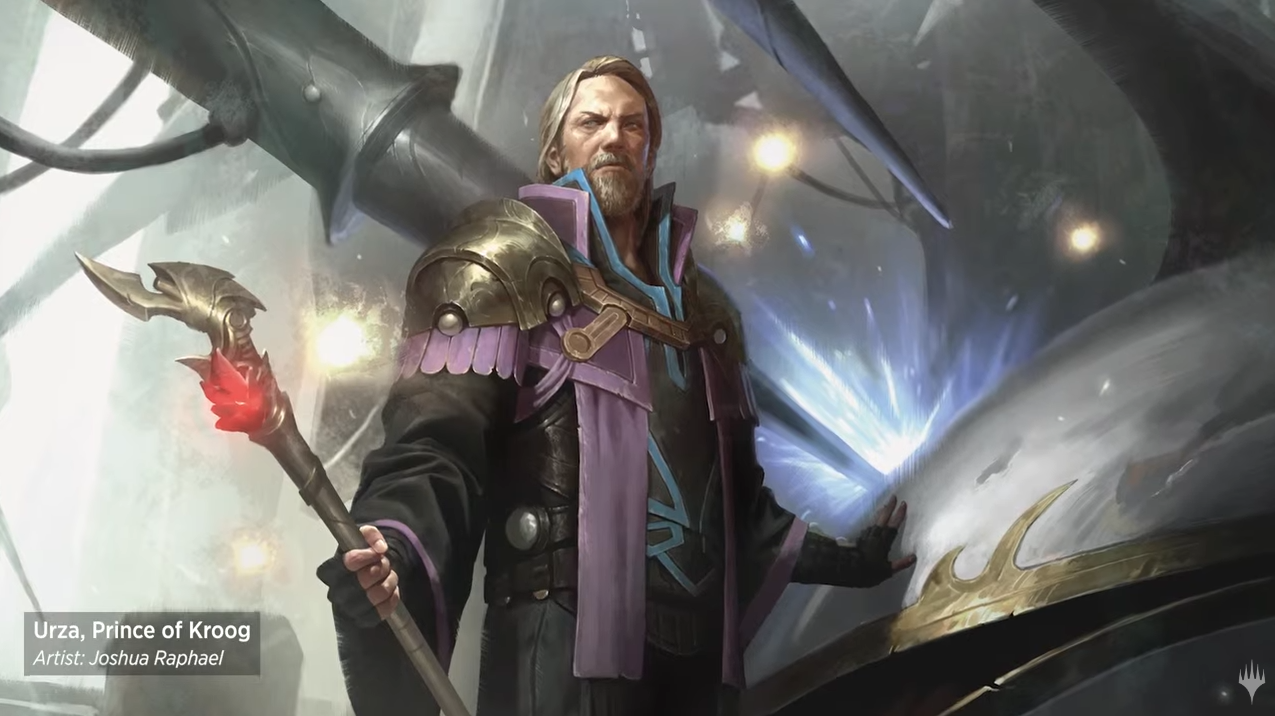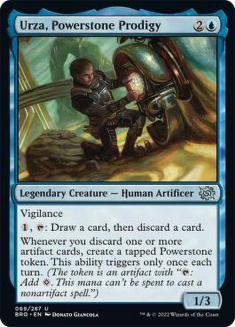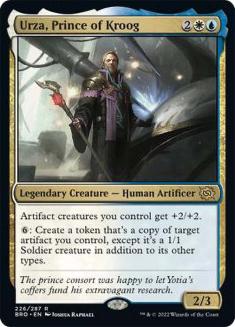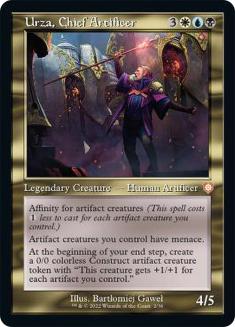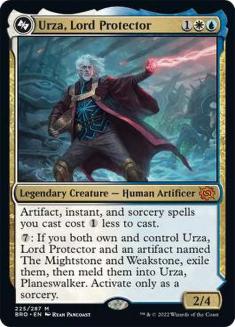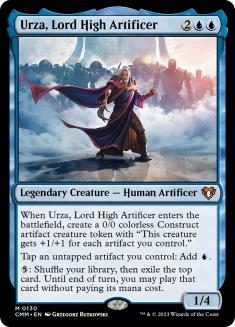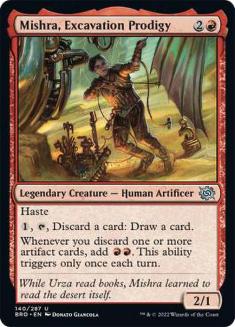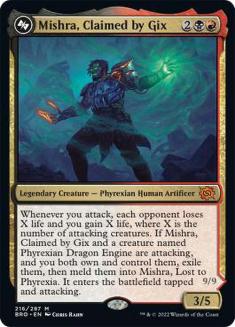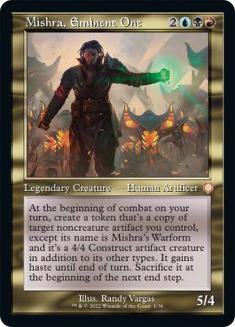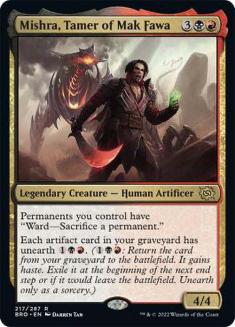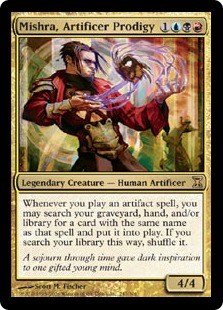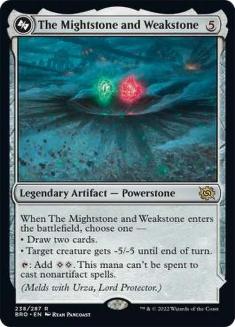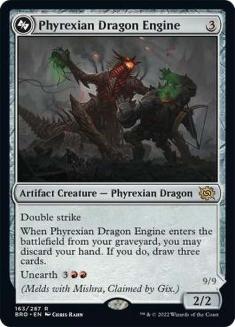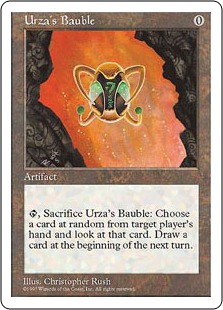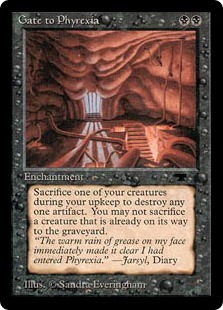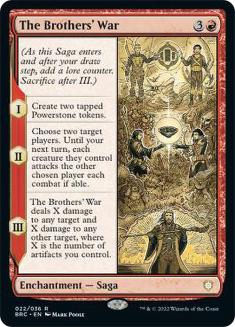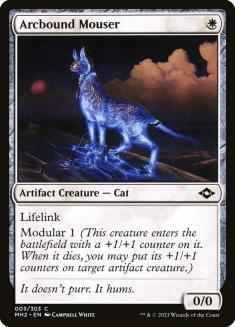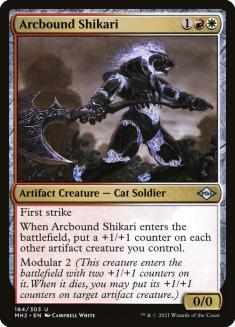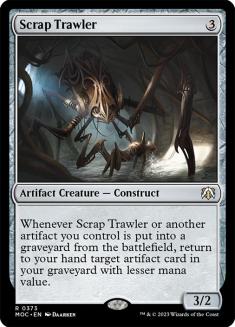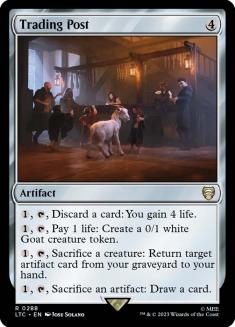We just got our first snow of winter here in Minnesota, which lines up well with The Brothers’ War releasing this week. It’s the perfect time to put on some tea, tinker with our Cubes, and try to forget that we live where the air hurts our face. Last week, I took to Twitter to see if there were any Cube topics pertaining to The Brothers’ War that interested people. With delight, I received this prompt from SCG’s own Joshua Kohnert:
I’m not the biggest Vorthos, so I’m not the guy to ask if you want a piece of art that’s properly evocative of the life and times of Urza and Mishra. That said, I’m exactly the guy to come to if you have an aesthetically-focused idea like this and want to translate it into a balanced play environment. It’s very common to see Cubes that are strictly focused on gameplay or strictly focused on aesthetics, but the marriage of these concepts leads to the most replayable Cubes in my experience.
I set aside some time this weekend and put together an initial sketch for a Brothers’ War Twobert. Today I’m going to walk you through my process for coming up with this list, and offer some general notes on how to take an abstract idea and turn it into a well-designed Cube.
Before I begin, it seems pertinent to offer a refresher on Twoberts. These are 180-card Cubes designed to be played by two to four players. For a more in depth look, check out my inaugural article on the topic. I also imagine that it’s preferable that I put the Cube list at the top of the article for those who would like to look it over as they follow along reading the design process. Here’s the Cube Cobra page for The Brothers’ War Twobert. That out of the way, let’s dig in!
The Idea
The first idea that ultimately becomes a Cube can either pertain to gameplay or aesthetics. For example, David McDarby’s Live the Dream Cube is an environment designed to make two-player Cube games that feel like Commander. My Tempo Twobert was designed to generate games that feel like old Legacy formats. The concept of a Brothers’ War Twobert doesn’t necessarily suggest anything about gameplay or power level. As such, we have to find some way to ground this aesthetic idea in terms of gameplay.
Some aesthetic ideas are more difficult to pin down than others, but The Brothers’ War as a concept gives us a lot to work with. In fact, just by identifying the two central figures in The Brothers’ War as Urza and Mishra, we get a lot of information about which direction to take the Cube. This all starts with a simple Scryfall search for the namesake characters:
It makes sense to me that if we want the Cube to feel like it’s about Urza and Mishra, we want a lot of Urzas and Mishras! We could just slap all of these cards into our list, but it’s worth taking the time to critically analyze how well these cards fit together before we do. All the Urzas and Mishras from The Brothers’ War and the corresponding Commander decks look like they can fit very well together in a balanced singleton environment. The others give me pause, though.
Mishra, Artificer Prodigy is a non-starter if you’re going to design a singleton Cube. I’m a major advocate of singleton, especially in smaller Cubes such as Twoberts, so that one won’t make the cut here. Urza, Lord High Artificer stands out in this list for a different reason: it’s just the most powerful card in this spread by miles as a combination mana engine and mana sink. Including these two cards just because they check our aesthetic boxes is a common pitfall that you’ll see Cube designers fall into as a way to favor aesthetics over gameplay. Neither card is going to make the cut for me.
I don’t think I need to say any more on Mishra, Artificer Prodigy, but I think it’s worth expanding on Urza, Lord High Artificer. When we start fleshing out the list, we’ll want cards that play well with and against the aesthetic flagships of our design. I want Mishra, Claimed by Gix and Urza, Prince of Kroog to be exciting cards to open. Neither holds a candle to Urza, Lord High Artificer. This disparity will only become louder as we add more cards, because those cards will either be competitive with Urza, Lord High Artificer, which probably means that they’re higher picks than the more reasonable Urzas and Mishras, or they’ll further cement Urza, Lord High Artificer as the most powerful card in the Cube.
No matter what you do, some card or another will be the most powerful and/or most desirable, so I’m not saying that this is inherently a problem. Rather, I’m saying that we can design the Cube in a way that the other Urzas and Mishras are the most appealing cards, and Urza, Lord High Artificer would be a really unbalanced addition to such an environment.
It probably goes without saying, but The Mightstone and Weakstone and Phyrexian Dragon Engine were also immediately locks for me. Meld is awesome, and this is the perfect Cube to put the Urza and Mishra meld pairs on display.
There are other characters and events involved in The Brothers’ War that will undoubtedly be making the Cube, but this first step in identifying these marquee cards will help greatly in informing our design. Now that we’re more grounded in gameplay and balance, it’s time to start fleshing that design out.
The Design
Next, I like to ask myself some broad-strokes questions. These can be revisited as the design evolves, but it’s good to get them on your radar. The first question that comes to mind looking at this card list is whether we want to just put a bunch of Urzas and Mishras in the Cube or otherwise strong-arm them into the experience with some kind of house rule. Personally, I like my Cubes to be as easy and familiar to pick up and play as possible, so my bias is heavily in favor of just putting a lot of Urzas and Mishras in the Cube and going from there, but it’s always good to ask the question.
Next, I have a couple of questions pertaining to the colors of the assorted Urzas and Mishras. Three-color cards present relevant questions that mono-color and two-color cards don’t, so I’m looking at Urza, Chief Artificer and Mishra, Eminent One and asking what they add to the Cube. They have cool effects, and they relevantly increase the volume of Urzas and Mishras, so I’m for keeping them in the spread. With our two major characters spreading into Grixis and Esper, though, it’s pretty loud to me that neither character is green. This raises the question of whether to-color restrict the Cube.
If you really want to hit all the right Vorthos notes, you’re probably in favor of including some Titanias and Tocasia, Dig Site Mentor. With Urza and Mishra caring so much about artifacts, I have a lot of reservations about branching into green. Green isn’t going to offer much to a deck built around any Urza or Mishra and worse, it’s going to need to offer players incentives to draft non-Urza or Mishra cards to be appealing. My verdict is that the gameplay would suffer too much for the inclusion of green, and that the exclusion allows us to have a very clear focus on “Urza vs. Mishra,” which is easy to understand even if you know next to nothing about the lore.
The last thing to consider regarding color is how you want to balance the color distribution. With Urza being base-blue and Mishra being base-red, there’s some desire to leave the colors unbalanced. There’s also some incentive to seed an Azorius deck that represents Urza’s ideals and a Rakdos deck that represents Mishra’s. Personally, I like flexible draft lanes, and specifically the three-color Urza and Mishra invite us to find some overlap between all the colors in the Cube.
There’s a pretty strong aesthetic justification for this overlap as well, with Mishra and the Phyrexians being interested in compleating everyone and with Urza’s own weak moral character. There’s a greater statement here about how much warring factions tend to actually have in common and the ugliness and futility of war, but I digress. This is all to say that it seems to me that the Cube should broadly be about artifacts, with each color and color pairing having a little bit of its own thing to do with artifacts that all have the ability to blend together in one way or another.
Building the List
Now we just need to get 180 cards on a list! Easy enough, right? That may sound daunting, but from what I know of Commander players, they whittle about that many cards down to 100 for their decks all the time. It’s all just a matter of knowing what resources to use to start.
The Brothers’ War aesthetic gives us an easy starting point: The Brothers’ War expansion! I pulled a lot of cards from the set, though notably my design is not close at all to being a Set Cube. I want a compellingly powerful environment. It just happens that the current era of Magic design gives us a lot of awesome new toys with nearly every release. Similarly, if I were to design a Cube with an Enchantress theme, you can expect that I’d use a lot of cards from Theros Beyond Death and Kamigawa: Neon Dynasty.
Next, I did some Scryfall searches for relevant characters in card names and flavor texts. I like the idea of including Urza’s and Mishra’s Bauble a lot. The flavor text of Ice Age Disenchant referencing The Brothers’ War was a particularly delightful find. The Brothers’ War Commander precons unsurprisingly had more to offer in them as well, not least the card also named The Brothers’ War!
I would say that my search for “war” in card names was mostly a waste of time, but it gives you an idea of the sorts of searches that I try. I also took the two minutes that it takes to look through the set Antiquities, knowing that it was the early Magic set that introduced The Brothers’ War to players. There’s not a lot there, but an old copy of Ornithopter is always nice to look at, and Gate to Phyrexia is an incredibly cool card that I was happy to put in the list.
Relevant keyword searches go a long way, too. Affinity, metalcraft, and improvise were all worth a look here. Searching for artifacts of particular colors went a long way in fleshing out each color’s column, too. This environment definitely values artifact as a card type highly, and any time that you have that sort of theme in a Cube, you can really narrow your searches. This is loudly on display in the white column, with the modular support from Modern Horizons 2 being heavily featured.
I made a point to generally avoid named characters that didn’t fit the aesthetic, but I always bias towards making the gameplay good over being 100% true to lore. I think it’s a good line to draw to not have named characters that aren’t relevant to The Brothers’ War be among the most powerful cards in the Cube, but I don’t want to make this an absolute rule to the play environment’s detriment. For example, I like Magda, Brazen Outlaw as a card that synergizes with Springleaf Drum and some other cards without being a bigger draw than any of the Urzas or Mishras.
Beyond that, I also wanted to feature cards that played to the strengths of the assorted Urzas and Mishras. “Artifacts matter” is a loud theme, but adding some stuff that worked with Urza, Powerstone Prodigy and Mishra, Excavation Prodigy’s triggered abilities from discarding artifacts sounded nice. Thirst for Knowledge, Faithless Looting, Smuggler’s Copter, and Goblin Welder all sounded great for this purpose. I did want to avoid anything too brutal with Goblin Welder, so I didn’t go for Wurmcoil Engine, but Meteor Golem loops sounded like something fairly aspirational that could be fun… at least the first time.
These searches gave me a great starting point for most of the colors and color pairs, and started to solidify what the environment would look like as well as better establishing the relative power level. From here I like to pull inspiration from both Cubes with similar aesthetics, as well as more generic Cubes, just to get the card list up to a functional point.
David McDarby’s Artifact Cube and my Artifact Twobert were both good resources for this list, and just any generic 540-card Cube as well as my series on the most broadly Cubeable cards in Magic are good resources at this stage in design. I actually ended up pulling quite a few cards from the Warhammer 40,000 Commander decks, which I knew to be a good resource for making black artifacts-matter decks work. Just being aware of major releases and other Cubes doing similar things to what you want to do is a great way to work smarter not harder in Cube design.
I’ll also note here that I deliberately didn’t go overboard on artifact beatdown decks with cards like Arcbound Ravager and a long list of nothing but cheap artifact creatures. I did pepper a lot of this in with cards like Steel Overseer, but I wanted to offer incentives to cast four- and five-mana spells, so I made sure to include a lot of cheap removal so that players could take more controlling roles and draft cool grindy cards like Trading Post.
I didn’t pay as much attention to the breakdown of the color of this Cube as I often do. This is largely because color restrictions make it a lot easier for the average draft to generate functional decks. The long colorless column adds to this as well. The average spell is just more castable in this environment than it is in the average Cube. I got to 24 white cards pretty organically and decided that was as good a number as any to build the other colors towards. I didn’t sweat classification of cards like Dismember or Porcelain Legionnaire too much, given that this is a rough sketch, but I start looking at that sort of thing more closely when I’m working on adding new cards to a Cube and I am moving things around by color.
Lastly, I’d like to offer some notes on selecting lands. Once I decided I wanted to include some three-color cards, I knew I wanted good mana fixing. The Cube’s color restriction actually made me much bigger on Triomes than I usually am, considering that they’ll pretty consistently find their way into decks utilizing all three of their colors. Fetchlands and shocklands are a good starting point just to make sure that manabases work, though I could realistically see peeling back on the power level of the mana a little if it feels like every deck is just four-color cards and the same spells make the maindeck every draft.
I specifically like the artifact Bridges from a gameplay perspective, and painlands fit really well here from an aesthetics perspective. There are enough lands featured here at a high enough power level that two- to four-color decks are possible, and actually drafting and playing the Cube will inform if it needs any tweaks to get more diversity in the cards that players actually play. Which brings us to our final section.
Development
From here, you play with the Cube and see what you like and dislike and modify the Cube to better fit your desires! I had Swords to Plowshares in the list briefly, but decided that Dispatch is a much better aesthetic match for the environment. I’m sure I would make a fair number of modifications along those lines as I drafted this Cube. Electrostatic Bolt over Chain Lightning is another potential swap that I’ve already strongly considered.
More importantly, I’d be keeping an eye on the cards that aren’t making decks as well as the cards that consistently dominate games. I’m a bit wary of Smuggler’s Copter as a power level outlier, for example. I’m also not sure if Tawnos, Urza’s Apprentice is playable. That’s easy enough to fix once you get playing. Remember, a Cube is never perfect, and a Cube design is never “done.” A big part of the joy for me is continuing to iterate. This list is just an hour or two of me brainstorming. I do think it looks pretty cool, but I’m absolutely certain that if somebody were to put it together, they’d invariably make changes that led them to enjoy it more than the Cube as presented.
If there’s anything that you like about Magic, I guarantee there’s a way to build an awesome Cube out of that idea. The 180-card size of Twoberts makes this considerably easier than trying to support more than four players, though the depth of quality designs in recent sets do give us a lot to work with for Cubes of any size. Whether you’re intrigued by my Brothers’ War Twobert or just came for the general notes on design, I’m grateful that you took the time to read today’s article. I had a lot of fun with this one.

